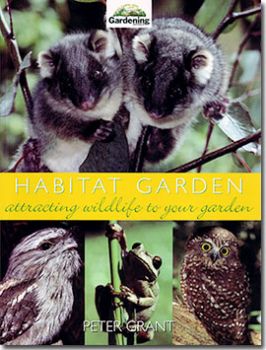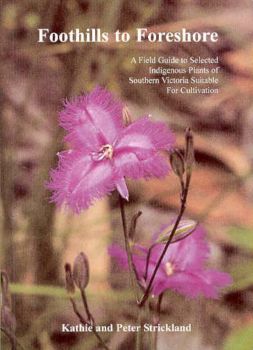|
[Front Page] [Features] [Departments] [Society Home] [Subscribe]

A Good Read
.....what's worth a look?
Reviews in this issue cover Habitat Garden - attracting wildlife to your garden by Peter Grant, Australian Fungi Illustrated by Ian McCann and Foothills to Foreshore by Kathie and Peter Strickland. |
 |

 
Habitat Garden - attracting wildlife to your garden
Peter Grant
Published by ABC Publishing, Sydney, 2003.
Paperback, 94 pages.
$A27.95.
Reviewed by Trevor Blake
 
What great timing for a great title on a subject where interest is expanding so rapidly.
With several years of severe drought, water reserves at their lowest ever, temperatures at all time highs, the Murray Darling with serious flow problems, to say nothing of the nation-wide, creeping, insidious salinity problem - a bleak picture if we want to dwell on it!
The responses and reactions to such doom and gloom possibilities indicate the alternative thinking and planning of individuals, groups, businesses and even governments to face the very real challenges ahead. Peler Grant with his book is one such response.
Gardening programs on radio, TV and the press are increasingly promoting much sounder attitudes to the ways we treat the land in which we live. Contributions of caring for the land can be made in small but sound ways on our own patch. This book has many practical approaches to the whys and how's of beginning a garden using many indigenous plants.
There are some useful charts indicaling the benefits of plant groups in supporting a range of wildlife. A section on the collection of local plant seed and various methods of propagation and treatment is backed by suggestions on the most successful times for sowing and taking cuttings.
The daunting task of tackling a new bare btock is addressed with some practical suggestions that work. It is quite evident that the author has been faced with this situation and has worked out solutions. He consistantly encourages the reader to observe how vegetation grows and is arranged in the wild and stresses the importance of establishing local species to provide maximum habitat lor indigenous wildlife.
Many tables accompany the text which he has tried to make useful to the entire nation - a very difficult task, but where local Landcare groups can give sound advice. Sound emphasis has been placed on water useage and its conservation through the choice of appropriate plants and the use of mulches.
I was surprised to see the alternative lawn suggestions omitted, perhaps the toughest and most adaptable grass for this use, Microlaena stipoides. I noted too in the first chart where Weeping Grass is mentioned that it should be Microlaena and not Erhartia which is the invasive 'Panic Veldt Grass'.
In the control of pest species of plants or animals a note of caution is advised which may encourage the gardener to think a little deeper of the consequences and reject the easy opiton and even accept some superficial damage so that the potential is thoroughly ascertained and maybe some kind of balance achieved.
A habitat garden with a cat is inviting destruction, no matter how well moggie is fed or how many bells are clamped around its neck. Remember the definition of a feral cat should be 'one that steps off the verandah'.
Gardens will be constantly changing as the environmental conditions and requirements alter. Various habitats, their protection, and food sources are all included in discussions. Feeding of wildlife, nectar bottles, seed trays and the provision of nest boxes receive attention and the detrimental sides of this 'goodwill' are presented. The smaller creatures, that are so vital in establishing an ecological balance, such as the invertebrates - spiders, dragonflies, butterflies, ants etc. are all considered. Lists of plants are suggested to provide for their needs.
Water gardening is explored with the appropriate approach to maintaining wildlife. A range of water loving plants are listed as are those that like wet feet but not constant immersion.
The final chapters deal with difficult areas to establish habitat, such as rain forest, alpine, arid and coastal sites. Help and advice is at hand once the decision is made to pick up the shovel and examples and contacts are discussed in this section.
The softback publication is a very practical guide to improving the biodiversity in gardens and throughout the pictorial sections is the constant inclusion of children exploring and discovering. This would be one of the most rewarding aspects of such endeavours and has the potential to unlock a lifetime of interest and awareness of future generations.
Well done Peter Grant! Highly recommended.
Reproduced from Growing Australian, newsletter of the Australian Plants Society (Victoria), December 2003.

 
Australian Fungi Illustrated
I R McCann
Published by Macdown Publications, Vermont, Victoria. May 2003.
A5, paperback, 128 pages.
$A30.00
Reviewed by Geoff Lay
 
This book marks a giant step forward for those interested in fungi in Australia. At last we have another small paperback book with copious labelled photos to take out into the field alongside "A Field Companion to Australian Fungi" by Bruce Fuhrer. Although there is some overlap between the two books, many of the species are different so the books are complimentary.
The book is aimed at amateurs and will suit people with no prior knowledge of fungi through to the dedicated enthusiast. Once you see some of the amazing diversity and beauty of these delicate structures it would be hard not to become another enthusiast.
Fungimap is a voluntary project devoted to mapping where 100 fungi species grow in Australia; 67 of the Fungimap species are illustrated in the book.
Over 400 species are shown in full colour photographs. Most photographs are close to natural size and for the others the degree of magnification is shown. For each photograph the family, genus and (where known) the species is given. The locality and substrata are listed, but neither spore colour nor texture is included. An interesting adjunct is the month when the photograph was taken as there are no guide books which give fruiting times for fungi.
Common names are also given for those not comfortable with scientific names.
The fungi are grouped by similarity of appearance with all species in the same genera arranged together for ease of comparison. The groupings are described on page 5. The first half of the book is devoted to the gilled mushrooms. Then follow sections on boletes, which have pores instead of gills; chanterelles that have ridges that resemble gills; the milk caps including the Lactarius which bleed a milky latex when changed.
The weird and wonderful follow - fungi shaped like teeth, brackets, coral, blobs of jelly or puffballs.
I tested this out on a day walk. Using just the illustrations and descriptions in the two books, my daughter was able to identify 27 different fungi she had never seen before on just one foray.
There are several minor spelling mistakes in the names. Hypocreopsis sp. one of the rarer Fungimap targets, is on page 106 but is not included in the index. Piptoporus australiensis, another Fungimap target, is incorrectly labelled Laetiporus australiensis on page 77.
The author lived near the Grampians so that area is well represented but the rainforest and semi-arid habitats are also extensively covered.
The author compiled this collection of photographs over 40 years and is to be congratulated on producing such a valuable reference tool for anyone interested in identifying fungi in the field.
Reproduced from Growing Australian, newsletter of the Australian Plants Society (Victoria), September 2003.
Note: Just after this review was written, we learned that on Tuesday 29 July 2003, Ian McCann died peacefully in his sleep.

 
Foothills to Foreshore: a field guide to selected indigenous plants of southern Victoria suitable for cultivation
Kathie and Peter Strickland
Published by Bloomings Books, Richmond, Victoria.
A5, paperback, 409 pages, 199 line drawings of plants.
$A32.950
Reviewed by Tony Cavanagh
 
The authors of this very useful guide are clearly passionate about the value of indigenous plants for revegetation and gardening.
They contend that as these plants have evolved over a long period in local soils and climate, they have the best chance for survival, especially under adverse weather conditions. The purpose of this book then is to provide information to gardeners and local landholders to encourage them to plant local species, and particularly to grow their own from either seed or cuttings from their local area. For this reason, the authors include a brief guide to propagation and cultivation practices in their introduction. The nearly 200 species have been selected from across Southern Victoria and many in fact also grow on the Mornington Peninsula where the authors for several years operated an indigenous plant nursery. The book is an outgrowth of their two earlier books on the flora of this area, with information updated and expanded. Kathie has an honours degree in Botany and provided the text while the excellent line drawings are Peter's work.
The authors have opted to arrange their species by habit, and within each habit they are arranged alphabetically by their Latin names. The habits chosen are trees, tall and medium shrubs (over 2 metres), small shrubs (under 2 metres), climbers and creepers, herbs (small, softer plants without woody parts) and tufted herbs. This arrangement assists to some extent with identification but as in nearly all field guides, there is still the difficulty for the novice user (who is usually unfamiliar with plant names anyway) in knowing where to start with the identification process. A double page spread is devoted to each species, with text information on the left and detailed line drawings produces from fresh material on the facing page. The species descriptions include flower, fruit and leaf details. These are precise and accurate but written in simple language and are backed up by a comprehensive glossary and a section with drawings of basic floral structures, leaf shapes, leaf arrangements and inflorescence types. The flower colour and flowering time is given separately.
The authors have gone to a lot of trouble to give the derivation or origin of the Latin names on the basis that once a user understands the meaning of the name, they may find it easier to remember it. They have included the family for each species and its common name as well as brief ecological information on its habitat, soils in which it grows, how it usually behaves in cultivation, the usual method of propagation and the community type in which it is found. This comprehensive information is backed up by the excellent line drawings of Peter Strickland. In some ways, it is a pity that these are not in colour which would further assist identification but I suppose that the cost of colour reproduction and the difficulty of finding suitable photographs of many of the smaller flowered species caused the authors to use black and white illustrations.
On the positive side, they have packed a lot of additional material into the illustrations. For instance, Banksia marginata on page 16 includes a flowering branch, a near life-size fruiting cone, examples of leaf variations including juvenile leaves, and details of individual seeds and the seed separator. Nearly every drawing is enhanced this way and the additional information, which is often enlarged, shows detail which we might otherwise not be aware of.
The book has a combined common name and Latin name index and a short bibliography which, however, should have included Corrick and Fuhrer's "Wildflowers of Victoria and adjoining areas" and the "Field guide to the native plants of Melbourne".
This is a well produced, accurate and informative guide to many of the lesser known indigenous plants of southern Victoria. Some are not as showy as the plants we often attempt to grow in our gardens but they are well worth trying because of their hardiness and ability to survive in tough local conditions. With a coverage of nearly 200 species, Foothills to Foreshore is good value and its A5 size makes it suitable for the backpack. However, you will have to decide whether you the black and white line drawings are adequate for your needs to identify species or whether you would prefer colour.
Recommended.
Reproduced from Growing Australian, newsletter of the Australian Plants Society (Victoria), September 2003.

[Front Page] [Features] [Departments] [Society Home] [Subscribe]
Australian Plants online - March 2004
Association of Societies for Growing Australian Plants
|